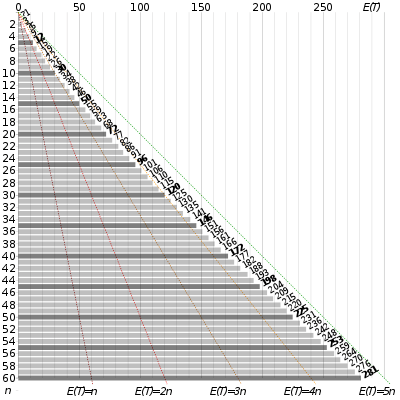Coupon collector's problem
In probability theory, the coupon collector's problem describes "collect all coupons and win" contests. It asks the following question: If each box of a brand of cereals contains a coupon, and there are n different types of coupons, what is the probability that more than t boxes need to be bought to collect all n coupons? An alternative statement is: Given n coupons, how many coupons do you expect you need to draw with replacement before having drawn each coupon at least once? The mathematical analysis of the problem reveals that the expected number of trials needed grows as .[lower-alpha 1] For example, when n = 50 it takes about 225[lower-alpha 2] trials on average to collect all 50 coupons.

Solution
Calculating the expectation
Let T be the time to collect all n coupons, and let ti be the time to collect the i-th coupon after i − 1 coupons have been collected. Think of T and ti as random variables. Observe that the probability of collecting a new coupon is . Therefore, has geometric distribution with expectation . By the linearity of expectations we have:
Here Hn is the n-th harmonic number. Using the asymptotics of the harmonic numbers, we obtain:
where is the Euler–Mascheroni constant.
Now one can use the Markov inequality to bound the desired probability:
Calculating the variance
Using the independence of random variables ti, we obtain:
since (see Basel problem).
Now one can use the Chebyshev inequality to bound the desired probability:
Tail estimates
A different upper bound can be derived from the following observation. Let denote the event that the -th coupon was not picked in the first trials. Then:
Thus, for , we have .
Extensions and generalizations
- Pierre-Simon Laplace, but also Paul Erdős and Alfréd Rényi, proved the limit theorem for the distribution of T. This result is a further extension of previous bounds.
- Donald J. Newman and Lawrence Shepp gave a generalization of the coupon collector's problem when m copies of each coupon need to be collected. Let Tm be the first time m copies of each coupon are collected. They showed that the expectation in this case satisfies:
- Here m is fixed. When m = 1 we get the earlier formula for the expectation.
- Common generalization, also due to Erdős and Rényi:
- In the general case of a nonuniform probability distribution, according to Philippe Flajolet,[1]
See also
Notes
- Here and throughout this article, "log" refers to the natural logarithm rather than a logarithm to some other base. The use of Θ here invokes big O notation.
- E(50) = 50(1 + 1/2 + 1/3 + ... + 1/50) = 224.9603, the expected number of trials to collect all 50 coupons. The approximation for this expected number gives in this case .
References
- Flajolet, Philippe; Gardy, Danièle; Thimonier, Loÿs (1992), "Birthday paradox, coupon collectors, caching algorithms and self-organizing search", Discrete Applied Mathematics, 39 (3): 207–229, CiteSeerX 10.1.1.217.5965, doi:10.1016/0166-218x(92)90177-c
- Blom, Gunnar; Holst, Lars; Sandell, Dennis (1994), "7.5 Coupon collecting I, 7.6 Coupon collecting II, and 15.4 Coupon collecting III", Problems and Snapshots from the World of Probability, New York: Springer-Verlag, pp. 85–87, 191, ISBN 0-387-94161-4, MR 1265713.
- Dawkins, Brian (1991), "Siobhan's problem: the coupon collector revisited", The American Statistician, 45 (1): 76–82, doi:10.2307/2685247, JSTOR 2685247.
- Erdős, Paul; Rényi, Alfréd (1961), "On a classical problem of probability theory" (PDF), Magyar Tudományos Akadémia Matematikai Kutató Intézetének Közleményei, 6: 215–220, MR 0150807.
- Laplace, Pierre-Simon (1812), Théorie analytique des probabilités, pp. 194–195.
- Newman, Donald J.; Shepp, Lawrence (1960), "The double dixie cup problem", American Mathematical Monthly, 67 (1): 58–61, doi:10.2307/2308930, JSTOR 2308930, MR 0120672
- Flajolet, Philippe; Gardy, Danièle; Thimonier, Loÿs (1992), "Birthday paradox, coupon collectors, caching algorithms and self-organizing search", Discrete Applied Mathematics, 39 (3): 207–229, doi:10.1016/0166-218X(92)90177-C, MR 1189469.
- Isaac, Richard (1995), "8.4 The coupon collector's problem solved", The Pleasures of Probability, Undergraduate Texts in Mathematics, New York: Springer-Verlag, pp. 80–82, ISBN 0-387-94415-X, MR 1329545.
- Motwani, Rajeev; Raghavan, Prabhakar (1995), "3.6. The Coupon Collector's Problem", Randomized algorithms, Cambridge: Cambridge University Press, pp. 57–63, ISBN 9780521474658, MR 1344451.
External links
- "Coupon Collector Problem" by Ed Pegg, Jr., the Wolfram Demonstrations Project. Mathematica package.
- How Many Singles, Doubles, Triples, Etc., Should The Coupon Collector Expect?, a short note by Doron Zeilberger.